Singapore's Diwali trains
Last October, Singapore’s Mass Rapid Transit (MRT) system covered the inside of its trains in vivid imagery and symbols with the occasion of Diwali - also known as Deepavali - the Hindu festival of lights, celebrated yearly in the northern hemisphere.
The colourful project was in its second year. Pictures posted by the Land Transport Authority showed train carriages featuring elephants, intricate Indian jewellery and rangoli motifs that symbolise luck.
The colourful trains, which ran on the North East and Downtown Lines, were joined by five Diwali-themed buses, all by-passing Singapore’s Little India neighbourhood, home to Singapore’s sizeable expat Indian population.
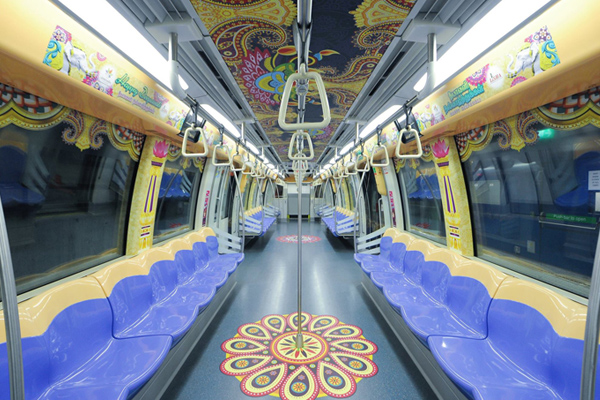
Credit: Land Transport Authority
The Heart of Russia
A Russian-themed tube ran for three months on London Underground’s Circle, Hammersmith & City and District lines, in celebration of the country's cultural achievements.
Called ‘The Heart of Russia’, the train was decorated red, white and blue – the colours of both Russia and Britain’s national flags – while the interiors of seven carriages were designed to familiarise passengers with Russia’s main achievements in science and the arts.
From images of the Nutcracker and the Bolshoi Theatre, to Kuzma Petrov-Vodkin’s famous painting the Bathing of the Red Horse, or the photos of St Basil’s Cathedral and the Ostankino TV Tower, more than one million commuters and visitors got the chance to experience the culture-filled trains.
And if these sparked their curiosity even further, posters with QR codes were placed at 20 London Tube stations for users to scan with their smartphones and download the Heart of Russia mobile app, which allowed them to learn more in-depth facts about key Russian figures.
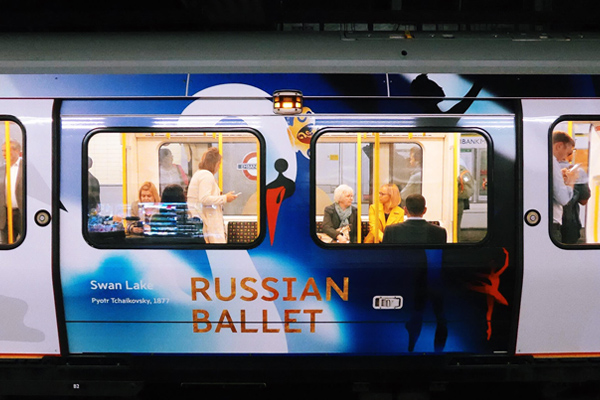
Credit: Art. Lebedev Studio
A Shakespearen Metro
To mark the 400th anniversary of William Shakespeare’s death in 2016, the British Council joined forces with Russia’s Moscow Metro and launched the ‘Shakespeare train’ – a modern, tongue-in-cheek play on the English author’s biggest legacy: his exploration of human emotions.
The outsides of the trains were decorated with photos of actors portraying famous characters, including Macbeth, King Lear, Romeo and Juliet, mixed with some of the most popular text-based emojis expressing love, hate, power and anger.
Inside, passengers could also read long quotations from his works, as well as take pictures of the installation at the designated ‘selfie points’ found at the end of each carriage. Shakespeare’s work enjoys widespread popularity in Russia to this day, with many of his plays being staged almost as often as in the UK.
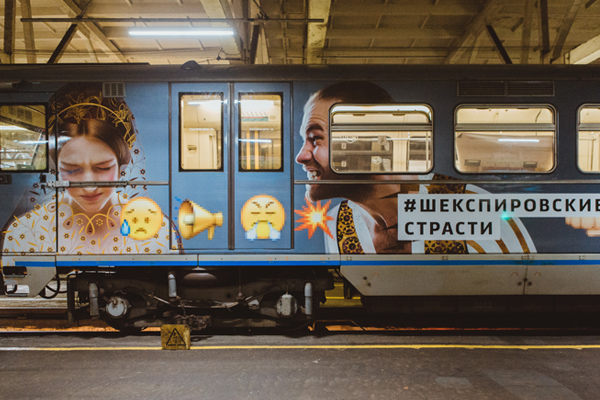
Credit: British Council Russia
Multicultural trains
A BRICS-themed subway train with carriages representing the five member nations (Brazil, Russia, India, China and South Africa) was launched in China’s south-eastern Xiamen in September last year. Made up of six carriages in total, five of them were dedicated to celebrate each individual member in turn, through its most memorable and stand-out symbols.
For example, the Chinese carriage was red and displayed icons such as the Great Wall and Tian’anmen Square, while the Brazilian carriage was painted green, adorned with images of footballs and football stars. Meanwhile, the Russian carriage showed off the country’s ballet legacy and matryoshka dolls, while the South African carriage displayed pictures of diamonds. A sixth carriage combined all cultural elements from all of the five countries in the bloc.
The subway train was launched with the occasion of the 2017 BRICS Summit, an international relations conference attended by the heads of state or heads of government of the five member states. Last year’s edition was held in Xiamen in September.
However, the multicultural subway wasn’t China’s first attempt at a themed train. In 2015, the city of Xi'an welcomed the Silk Road train, also formed of six carriages celebrating themes such as exploration, inclusiveness, mutual benefit and co-operation through hand-drawn pictures of desert and camels, markers of the ancient silk trade route.
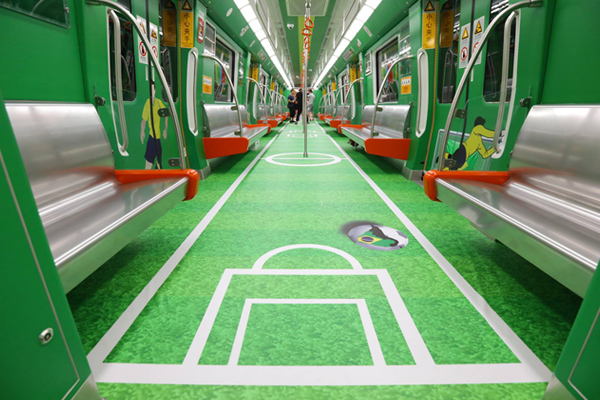
Credit: People Daily, China
Seoul’s Olympic trains
This year’s Olympic and Paralympic Winter Games are hosted by South Korea’s Pyeongchang, and to honour the occasion, Seoul launched an ‘Olympic subway’, decorated with sports paraphernalia such as PyeongChang official mascots Soohorang and Bandabi, and ads for official goods, including beanies, gloves and jackets.
One of the cars has been completely transformed to resemble a bobsled track, while another is done up as the Gangneung Curling Center. The Olympic subway cars are currently operating about six times per day over the course of three months, starting in November 2017.
What’s more, Mongchontoseong station has been rebranded as the PyeongChang 2018 station, and is covered with three-dimensional artworks celebrating Korea’s iconic winter sports moments, honoured Olympians, and striking images of PyeongChang’s local scenery.
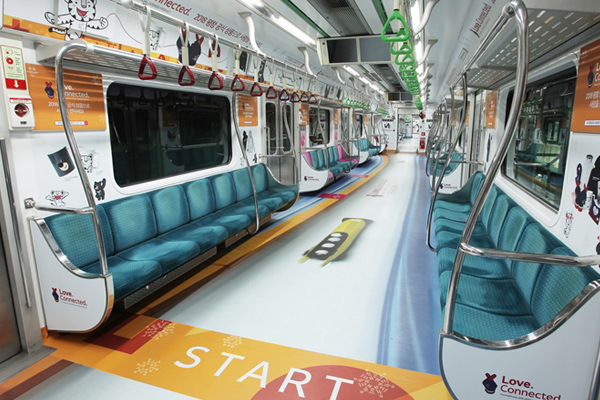
Credit: Pyeong Chang 2018
A journey through anime
Japan’s anime culture has become a worldwide phenomenon, with entire franchises captivating the imaginations of cartoon fans and gamers everywhere. Now, train passengers can see some of the country’s most popular characters up close, by riding on the Pokémon, Sage, Doraemon, Chunibyo or Moomin trains.
For example, the Pokémon with You train has been running since 2012 in the Tohoku region on the Ofunato Line. It was originally launched to cheer up both children and adults in the wake of the 2011 Tōhoku earthquake and tsunami, but it proved popular and now seems to be a permanent fixture. Inside, no two seats look the same, while each carriage depicts traditional landscapes and symbols found across the Pokémon universe.
Another well-known mascot that took over public transport was Sonic the Hedgehog, to mark the 25th anniversary of video game franchise Sega in 2016. For just one month, Tokyo’s Blue Sky metro line featured Sonic-blue images and graphics, to the delight of commuters and visitors alike. In the Kansai area, a limited edition train also featured a newer character, Chuni-byo, the protagonist of a more modern, but very popular anime in Japan.
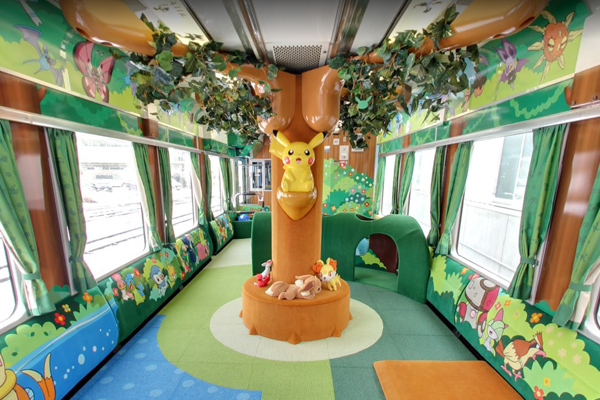
Credit: Google Maps